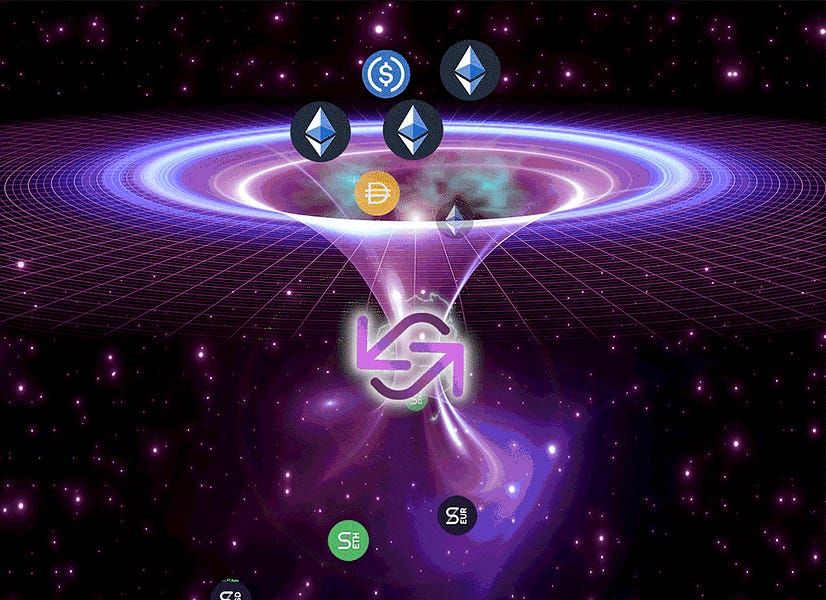Uniswap is Infrastructure

Level up your open finance game three times a week. Subscribe to the Bankless program below.
Dear Crypto Natives,
Uniswap isn’t just a decentralized exchange—it’s probably the most powerful money protocol built on Ethereum since Maker.
David Hoffman explores Uniswap’s transformative power in today’s Writers Corner.
- RSA
WRITERS CORNER
By Bankless writer: David Hoffman, COO RealT & POV Crypto host
Uniswap is Infrastructure

My two most recent articles have discussed the concept of Ethereum applications being used as infrastructure for other applications.
Specifically, they illustrate how computer applications are better, stronger, more reliable infrastructure for other applications.
A couple premises have developed from this:
- The more ‘computer’ and less ‘human’ an application is, the more other applications are able to leverage it as dependable infrastructure.
- The more computer-applications there are, the easier it is to build further applications, both human and computer.
This is basically the concept we know as “composability”, with a slightly new flavor:
“Composability begets composability, and computer-application composability begets computer-application composability”
In this article, we’re going to explore how Uniswap acts as infrastructure for other projects and protocols to leverage, and what characteristics about Uniswap specifically enable it as good infrastructure.
Decentralized Oracle
An under-appreciated (and perhaps under-utilized) function of Uniswap is that it can act as a price feeds for any token in its system. Every token inside of Uniswap is paired with a corresponding amount of ETH, and “the market” is pricing these things two things in relation to each-other.
The Uniswap ETH/DAI market is liquid enough to produce a trustworthy and costly-to-attack price feed for the ETH-DAI price. The whole rest of Ethereum can access the ETH-DAI price, and use it as an accurate proxy for the ETH-USD price.
The importance of decentralized oracles inside of Ethereum cannot be understated. Overcoming the obstacle of getting outside-world information onto Ethereum in a trustless/uncensorable manner will unlock an entirely new landscape of possible applications that can be built.
Uniswap is not utilized as an oracle for many (any?) Ethereum applications at the moment, however some websites like Security Token Market have begun to use it to display data. I expect many applications to use Uniswap as a price-feed oracle in the long term.
Synthetix Portal
The sETH/ETH market on Uniswap is the most liquid exchange there is. With 44,000 ETH in the market, it beats the 2nd largest market (MKR/ETH) by 11k ETH.
This is no accident. sETH plays an important role in getting value and liquidity into Synthetix’s Synth assets.
Most Uniswap markets like MKR/ETH or DAI/ETH are simply just places to swap assets, just like any other exchange. However, the sETH/ETH pair is fundamentally different.
With sETH/ETH you are trading two assets of equal value. Why would you ever do this?

Uniswap: Portal to Synthetix
sETH is the portal between Ether and all of Synthetix’s Synth assets. The Uniswap pair for sETH/ETH is the bridge of value transfer between the Ethereum and Synthetix ecosystem.
In theory, you could have sUSD/DAI pairs, sBTC/WBTC, or sMKR/MKR Uniswap exchanges, each acting as an on-ramp to Synthetix. sUSD/ETH does actually exist, but at 1,100 ETH in liquidity, its just 1/40th the size of sETH/ETH.
This is just how liquidity works; liquidity begets liquidity. It’s simply more efficient if the onramp to Synthetix was one 8-lane highway than eight 1-lane country roads.
This is what the sETH/ETH trading pair is, and is what Uniswap is uniquely able to provide.
The best part about the Synthetix/Uniswap integration is that Synthetix is always able to depend on Uniswap to be there. If the main thoroughfare to sETH was through Binance, and Binance encountered a failure scenario, then the Ethereum-Synthetix bridge would collapse. SNX returns are based on volume as well, so this would be particularly bad if liquidity dried up from Synthetix turning into a closed-system with no portal back to Ethereum.
Because Synthetix can depend on Uniswap to always be there, Synthetix has created its own incentive-system for those that provide liquidity in the sETH/ETH pair. LPs to the sETH/ETH Uniswap pair receive extra SNX dividends. This is basically Synthetix funding the development/maintenance of an 8 highway between Ethereum and Synthetix.
Uniswap is such a trustless piece of infrastructure, that Synthetix can add incentives or manipulate the market as it needs to benefit itself. Uniswap, as an inherently agnostic piece of code, is entirely agnostic to how other protocols or projects leverage it.
RealT (security token) Liquidity
At RealT (my company), we issue tokens that represent ownership in U.S. real estate properties. The legal mechanism that creates the link in ownership between the token and the asset results in these tokens being tokenized securities.
There are fewer things with less liquidity than both real estate assets, and tokenized securities.
However, with Uniswap, RealT is able to provide an on/off-ramp between our tokenized real estate assets, and ETH. Uniswap Exchange is the largest holder of the two properties that we have completely sold on Ethereum. Following in Synthetix footsteps, we have recently introduced our own liquidity-incentive system for RealT’s third property.
Uniswap has been crucial infrastructure for us at RealT, as it provides the first liquidity mechanism for the worlds most illiquid asset class (real estate), and also brings investor confidence that they will be able to liquidate their position if necessary.
Currently, each RealT property has their own unique market. This does not follow the principle of liquidity begets liquidity, and results in a lower-than-ideal total liquidity measure for all RealTokens. RealT v2 is currently in the works and addresses this issue, by placing all RealTokens inside the same market, the same way that Synthetix put its entirely liquidity profile inside of sETH/ETH.
EXCHANGE_SEND
Uniswap allows you to swap any token with any token. However, one simple addition that uniswap.exchange has in its UI, and is trivial to build into other Uniswap UI’s is the option to change the receiver of the exchange.
This results in a send_receive function that is also an exchange between two assets. If you, or your application, has DAI, but needs to send ETH/WBTC/MKR/USDC/SNX/whatever, you can make a single transaction that passes the money through Uniswap and out the other side.
Any application can leverage this function for whatever reason. I expect it to be a well-utilized function of Uniswap in the future.
Two things of note
- When you use this function, you pay Uniswap slippage costs. Sending large amounts through the ETH/WBTC or ETH/sUSD pool would result in significant slippage costs. Illiquid exchanges will not experience much volume from this mechanism, due to the extra costs associated with trading illiquid assets.
Liquidity is a function of market-cap. If you want every Uniswap exchange to become more liquid, you need the traded assets to have higher market caps. If you want more people to use Uniswap, ETH price must go up. - As pairs become more liquid, the EXCHANGE_SEND function actually becomes more useful. Liquidity inUniswap pairs grows when the total volume (aka total fees) also grows. If more volume goes through Uniswap pairs, there are more fees to be collected LPs. If one application uses Uniswap’s EXCHANGE_SEND function, then the fees they pay make that particular Uniswap market more lucrative, which incentives more liquidity, and therefore reduce future Uniswap slippage costs.
Which brings me to my next point…
Scale
Uniswap scales with the economic world around it. The size of any given Uniswap market is correlated with the volume that flows through it. The more volume a market does, the more fees that market collects. The more fees a market collects, the more incentive there is for people to come and provide liquidity.
- The more that people provide liquidity to Uniswap, the more liquid the market is.
- The more liquid the market, the more it will be used by more participants making larger trades.
- When more participants make more, larger trades, the total fees in that exchange go up, increasing the incentive for further liquidity.
The summary of these points: Uniswap organically scales up to meet demand. It will always be able to serve the needs of the market around it. It does this automatically.
Building on Uniswap is Reliable
Uniswap’s killer feature is that its you can rely on it as infrastructure. Applications on Ethereum are built with varying amount of human/computer control. Uniswap however, is a fully-computerized application. No single human has control over any particular Uniswap exchange, and therefore Uniswap exchanges are basically guaranteed to be functioning until the end of Ethereum.
If you are a person or entity that is interested in the downfall of a particular Uniswap market, in order to kill that market you would need to kill Ethereum itself. The advantage of computer-only applications like Uniswap is that they are able to outsource their security to Ethereum. If you want to stop Uniswap, you must stop Ethereum.
Shielded by Ethereum
Uniswap brought in $1.2M in fees in 2019. In contrast, Ethereum brought in $34.58M in fees. Generally speaking, the thing that earns 30x more fees will be at least 30x harder to kill. If you are an entity that competes with Uniswap, you might be financially incentivized to kill Uniswap. However, does Uniswap’s $1.2M in revenue really incentive you enough to spend the $35M necessary to kill Ethereum? Probably not.
Comparing Uniswap fees vs Ethereum fees is apples to oranges, but I believe it works as an accurate measure of the total effort that someone would need to go to, to disrupt a system, and also the decree at which someone may be incentivized to do so.
More to Come
Uniswap is Ethereum’s first example of a fully autonomous financial application that has significantly impacted the internal Ethereum economy. Others are sure to come. This article uses Uniswap as a case-study, but this same pattern of composability is not unique to just Uniswap.
Fully autonomous applications like Uniswap on Ethereum will be the reason why Ethereum takes over and replaces the Earth’s financial networks.
They are simply better financial tools that cannot be replicated without crypto-economcs. Uniswap’s ability to automatically scale to meet demand means that it already has what is needed to serve any future demand that comes to it. Applications like Uniswap that rely on crypto-economics for their functioning are likely always going to beat out human ones, due to the characteristics illustrated in this article.
- Utility
- Reliability
- Scale
Thanks for reading!
Please follow me on twitter @trustlessstate
Author Blub
David Hoffman is the Chief of Operations at RealT and host at POV Crypto. He writes on open finance and Ethereum topics. Check out his recent talk on how ETH accrues value and this accompanying post. (RSA note: this video one of two 4 x 🔥I’ve ever given—highly recommended)
Subscribe to Bankless. $12 per mo. Includes archive access, Inner Circle & Deal Sheet.
Not financial or tax advice. This newsletter is strictly educational and is not investment advice or a solicitation to buy or sell any assets or to make any financial decisions. This newsletter is not tax advice. Talk to your accountant. Do your own research.
Disclosure. From time-to-time I may add links in this newsletter to products I use. I may receive commission if you make a purchase through one of these links. I’ll always disclose when this is the case.